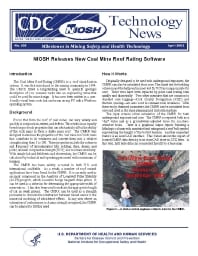Mining Publication: Technology News 505 - NIOSH Releases New Coal Mine Roof Rating Software
Original creation date: April 2003
Authors: National Institute for Occupational Safety and Health
NIOSHTIC2 Number: 20022576
Pittsburgh, PA: U.S. Department of Health and Human Services, Public Health Service, Centers for Disease Control and Prevention, National Institute for Occupational Safety and Health, Technology News 505, April 2003; :1-2
The Coal Mine Roof Rating (CMRR) is a roof classification system. It was first introduced to the mining community in 1994. The CMRR filled a longstanding need to quantify geologic description of coal measure rocks into an engineering value that could be used for mine design. It has now been written to a user-friendly visual basic code that can be run on any PC with a Windows operating system. Rocks that form the roof of coal mines can vary widely and quickly in composition, extent, and defects. This results in an equally broad range of rock properties that can substantially affect the ability of the rock mass to form a stable mine roof. The CMRR was designed to evaluate the properties of the coal mine roof rock mass that contribute to its weakness and convert them into a relative strength rating from 0 to 100. These properties include the cohesion and frequency of discontinuities like bedding, slips, shears, and joints; uniaxial compressive strength (UCS); and moisture sensitivity. With simple lab and field tests and observation, the CMRR can be calculated by technical and operating personnel with a minimum of training. The CMRR has been widely accepted in both U.S. and international coalfields. As a result, a number of roof control applications have been found for the CMRR. It is currently used as an input component in the Analysis of Longwall Pillar Stability (ALPS) program, which is used to design longwall chain pillars. It can be used as a criterion for determining the appropriate width of mine entries. It has also been used to indicate the appropriate length of cut in weak ground. The CMRR can be used as a strength parameter to characterize interburden between mined seams in the numerical modeling of subsidence effects. In any area where an estimation of coal measure rock mass strength is required, the CMRR can be adapted to fill this need. Originally designed to be used with underground exposures, the CMRR can also be calculated from core. The chisel test for bedding cohesion and the ballpeen hammer test for UCS are inappropriate for core. These tests have been replaced by point load testing both axially and diametrally. Two other measures that are common to standard core logging-Rock Quality Designation (RQD) and fracture spacing-are also used to estimate rock weakness. With these easily obtained parameters, the CMRR can be calculated from core and used in the mine planning and exploration phase. The input screens allow calculation of the CMRR for both underground exposure and core. The CMRR is reported both as a "dry" value and as a groundwater-adjusted value for moisture-sensitive rocks. There is a graphical output report featuring a lithologic column with annotated unit ratings and a roof bolt symbol representing the height of the bolted horizon. Another important feature is an AutoCAD interface. This feature allows the export of located CMRR data directly to an AutoCAD layer in XYZ form. In this way, drill hole data can be inserted directly to a base map.

NIOSHTIC2 Number: 20022576
Pittsburgh, PA: U.S. Department of Health and Human Services, Public Health Service, Centers for Disease Control and Prevention, National Institute for Occupational Safety and Health, Technology News 505, April 2003; :1-2